iterationiterationYHisSoftware testing models represent organized methods for assessing and confirming the quality of software programs. These models offer a structure for pinpointing and rectifying flaws, guaranteeing that the software aligns with user anticipations and complies with set standards.
Testing software is a crucial component of the software development lifecycle (SDLC), guaranteeing the provision of top-notch, dependable software solutions.
What is the Importance of Software Testing Models?
Software testing models play a crucial role in ensuring the quality and reliability of software. They offer structured approaches to identify and rectify defects, aligning the software with user expectations and regulatory standards.
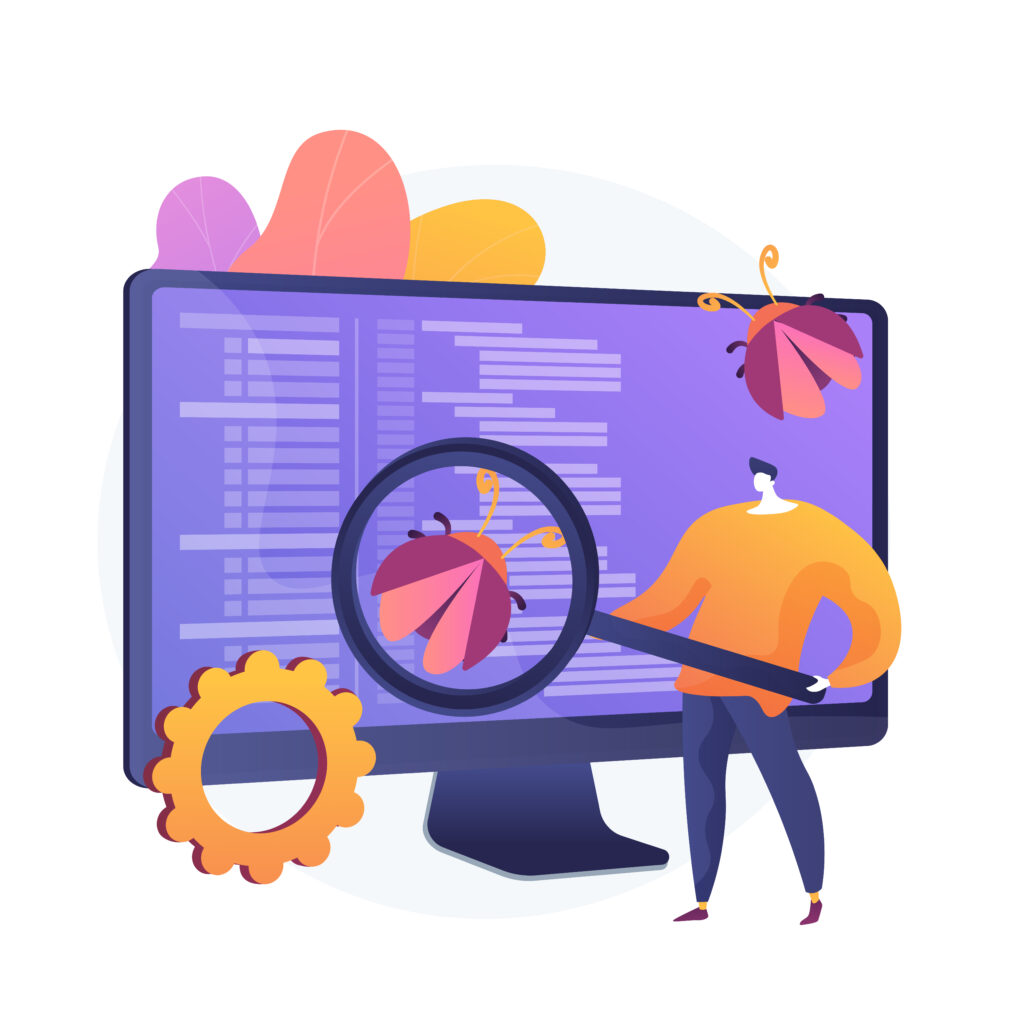
One of their primary benefits is early defect detection, which significantly reduces the cost and complexity of addressing issues. This proactive approach not only saves money but also enhances overall software quality. This will result in a more reliable and user-friendly product.
Additionally, these models help minimize the risk of software failures. This can have severe consequences for businesses, including downtime, data breaches, and reputational damage. By identifying potential issues early on, they contribute to smoother operations and increased customer satisfaction.
Satisfied customers are more likely to continue using the product and recommend it to others, emphasizing the importance of delivering high-quality software.
Moreover, software testing models assist companies in obeying with regulatory requirements specific to various industries. This ensures that the software meets legal standards and industry-specific criteria, avoiding potential legal complications. Investing in effective testing models upfront proves cost-effective in the long run by reducing the need for costly rework and maintenance.
Furthermore, these models streamline the software development process, leading to improved productivity and quicker time-to-market for software products. They also promote collaboration between developers and testers, fostering better communication and understanding of project requirements. This collaborative effort results in a more cohesive and effective development process, benefiting the entire team and ultimately, the end-users.
Types of Software Testing Models
Different types of software testing models have been developed, each presenting distinct advantages and drawbacks. Selecting a testing model is influenced by the particular needs of the project, the intricacy of the software, and the resources at hand.
Now, let’s explore the main features, benefits, and drawbacks associated with various software testing models:
Waterfall Model – A Sequential Software Testing Model
The Waterfall Model divides the software development process into distinct phases, where the output of one phase becomes the input for the subsequent phase.
The model encompasses four main phases: requirement gathering and analysis, software design, programming implementation and testing, and maintenance. These phases proceed in a sequential order.
The first phase, requirement gathering and analysis, involves identifying and documenting all potential system requirements for a specific software project. This is based on detailed software requirement specifications that encapsulate user preferences.
The resulting Requirement Specification document feeds into the software design phase. It’s crucial to note that once a phase is completed, revising the requirements becomes impractical, emphasizing the importance of clear understanding and careful consideration of user needs.
The four core stages of the Waterfall Software Testing Model are:
1. Requirements Gathering and Analysis: This phase entails collecting, assessing, and documenting system requirements to comprehend the software’s intended functionality and user expectations. It culminates in a Software Requirements Specification (SRS), laying the groundwork for subsequent development phases.
2. Software Design: Building on the SRS, this phase translates requirements into a comprehensive technical blueprint. It involves outlining the software architecture, pinpointing hardware and software components, and detailing specifications for each element to ensure alignment with the requirements.
3. Programming Implementation: Once design specifications are finalized, developers commence coding, adhering to established standards and best practices. This phase encompasses writing, testing, and debugging to ensure each component functions correctly and aligns with the design.
4. Testing: After full implementation, the software undergoes rigorous testing to pinpoint and rectify defects, ensuring it aligns with requirements. This phase includes unit testing, integration testing, system testing, and acceptance testing.
5. Maintenance: The model concludes with maintenance, addressing post-release issues, bug fixes, and enhancements based on user feedback to maintain software stability and performance.
Advantages of the Waterfall Model:
- Structured Model: Offers a clear framework for managing and tracking project progress.
- Early Requirement Definition: Minimizes costly changes by defining requirements upfront.
- Emphasis on Documentation: Promotes transparency and facilitates knowledge sharing among team members.
Disadvantages of the Waterfall Software Testing Models:
- Rigidity: Difficult to adapt to changing requirements or unexpected issues.
- Late Testing: Testing at the end can lead to costly rework and delays.
- Limited Adaptability: Not suitable for projects with evolving requirements or continuous feedback needs.
V Software Testing Model – Integrating Verification and Validation
The V Model also termed the Verification and Validation Model, blends the structured approach of the Waterfall Model with the flexibility of Agile methodologies.
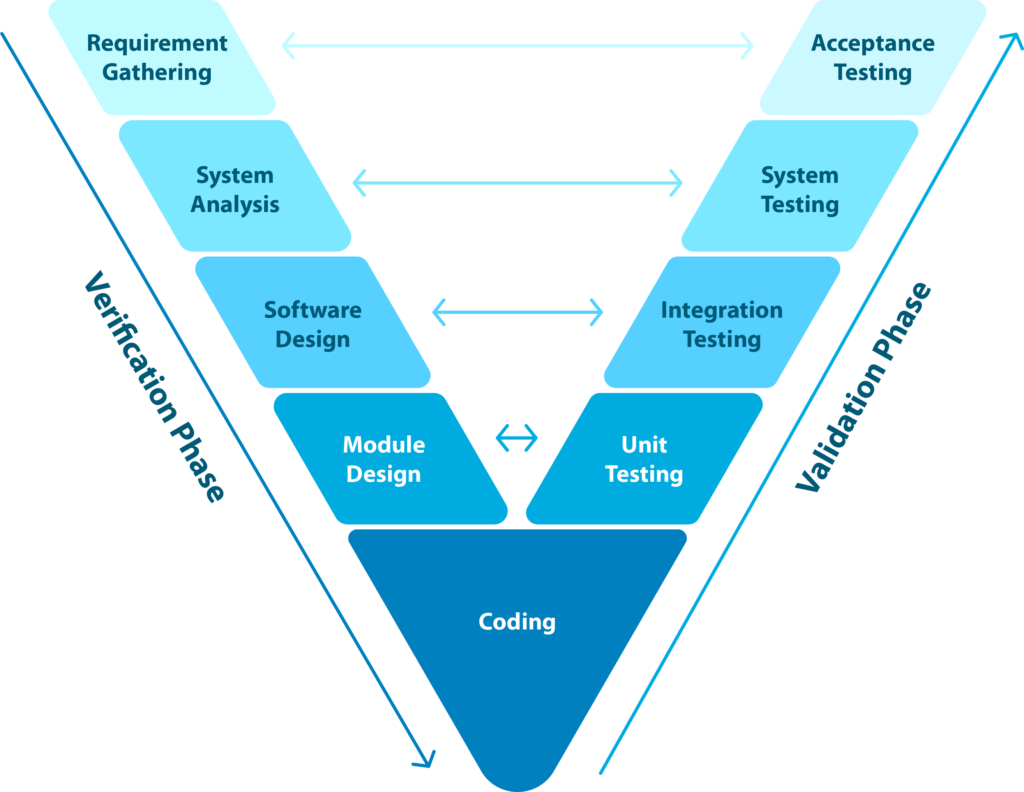
This model introduces testing activities throughout the development process, forming a V-shaped pattern where development stages (planning, design, coding) correspond with testing stages (unit testing, integration testing, system testing, acceptance testing).
The V Model consists of five distinct phases: Unit testing, Integration testing, Regression testing, System testing, and Acceptance testing.Software Testing Models
Advantages of the V Model:
- Early Defect Detection: Integrating testing across all development phases facilitates early identification and rectification of defects, minimizing rework costs.
- Enhanced Communication: Promotes collaboration between developers and testers, fostering a deeper understanding of requirements and ensuring software alignment with its intended purpose.
- Structured Flexibility: Offers a structured framework with adaptability to evolving requirements.
- Suitable for Medium-sized Projects: Ideal for moderately complex projects where requirements may undergo partial changes during development.
Disadvantages of the V Model:
- Clear Initial Requirements Needed: Relies on upfront clarity and definition of requirements, which might be challenging for projects with dynamic needs.
- Testing Complexity: Coordinating multiple testing phases concurrently requires meticulous
planning and management. - Upfront Planning and Documentation: Demands comprehensive planning and documentation initially, potentially increasing the project’s initial workload.
The Agile Software Testing Model: Valuing Adaptability and Continuous Improvement
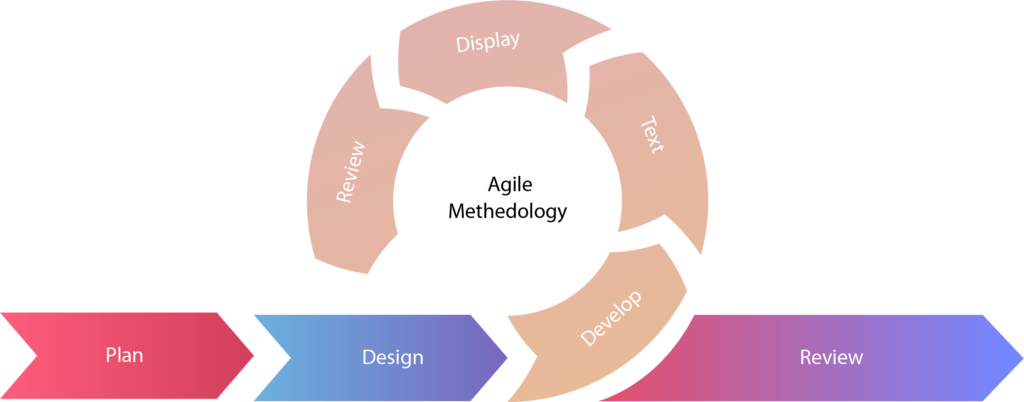
The Agile approach to software development is characterized by its iterative and progressive nature, prioritizing adaptability, flexibility, and ongoing input from customers. It promotes teamwork among diverse functional groups and divides the development procedure into smaller, more manageable phases known as iterations.
Each of these iterations aims to deliver a functional segment of the software, facilitating constant testing, fine-tuning, and adjustment in response to evolving demands. Such a method empowers companies to swiftly adapt to market shifts and consistently offer value to clients in a timely manner.
Core Features of the Agile Model:
- Step-by-step and progressive development: Firstly, the software is crafted in compact stages. with every stage presenting a functional product to clients.
- Ongoing evaluation and feedback: Secondly, assessment is woven into the entirety of the development journey, ensuring ongoing insights for developers and interested parties.
- Fluidity and responsiveness: The Agile approach accommodates modifications in specifications and task priorities as the project unfolds.
- Teamwork and interaction: Finally, agile squads operate within an environment that encourages cooperation and open dialogue. This will enhance mutual comprehension and collaborative problem-solving.
Benefits of the Agile Software Testing Models:
- Timely and consistent delivery of benefits: Clients are provided with functional software components on a regular basis, facilitating continual feedback and realization of value.
- Diminished risk and superior quality: Persistent testing and feedback mechanisms enable early detection and resolution of issues, boosting the overall quality of the software.
- Greater resilience to change: The adaptability inherent in the Agile approach facilitates adjustments to shifting specifications and market dynamics.
- Strengthened team synergy and communication: The Agile methodology fosters teamwork and effective communication among members, resulting in improved understanding and problem-solving capabilities.
Drawbacks of the Agile Model:
- Necessitates preliminary planning and dedication: Successful execution of Agile initiatives demands meticulous planning and synchronization to maintain effective iteration sequences.
- May entail a shift in organizational culture: Embracing an Agile mindset might necessitate cultural shifts within the organization.
- Risk of expanding project scope: The inherent flexibility of the Agile approach can potentially result in project scope expansion if not properly managed.
- Not universally applicable: Agile might not be the most suitable approach for projects characterized by stringent specifications or those demanding extensive initial planning.
The Spiral Software Testing Model: Prioritizing Risk Management and Step-by-Step Development
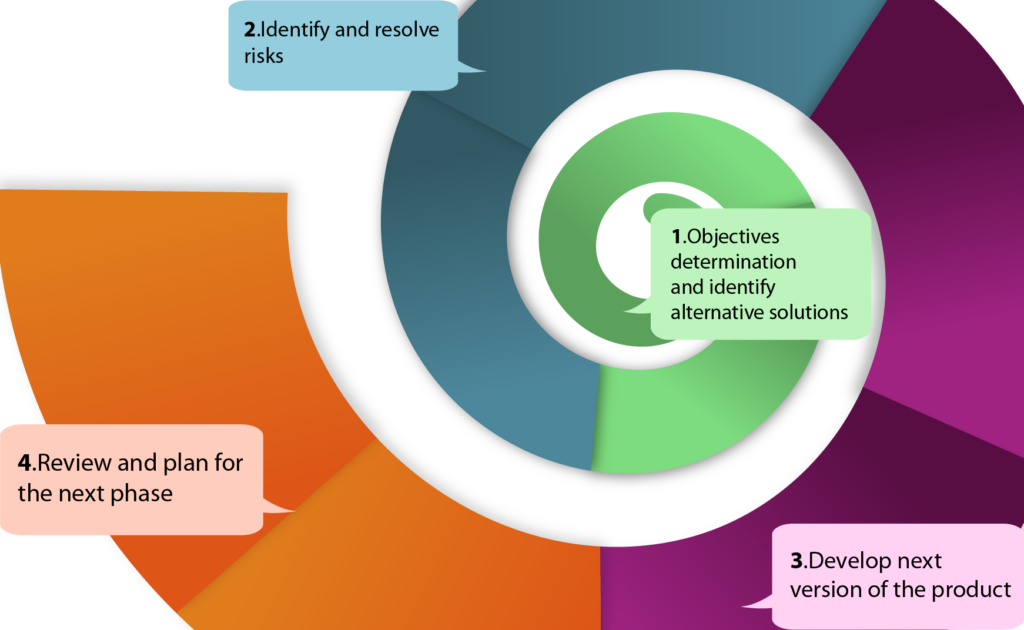
The Spiral Model is a method of software development that is driven by risk assessment. This combines iterative practices with a methodical and monitored strategy. While it bears resemblance to the Agile Model in its iterative nature and focuses on the early detection of defects. It places a greater emphasis on the ongoing evaluation and management of risks throughout the development phase.
Core Features of the Spiral Approach:
- Risk-focused methodology: Every iteration in the Spiral Model is centered around the identification and mitigation of risks, ensuring potential challenges are recognized and tackled promptly.
- Incremental development: In alignment with Agile practices, the Spiral Model divides the software development process into smaller, manageable segments, promoting continuous improvement and adaptability.
- Structured and supervised: Despite its iterative approach, the Spiral Model adheres to a well-defined framework that strikes a balance between flexibility and oversight.
- Customer engagement: The Spiral Model places significant importance on integrating customer feedback throughout the development process, guaranteeing the final product aligns with user expectations.
Core Features of the Spiral Model:
- Risk-focused methodology: Every iteration in the Spiral Model is centered around the identification and mitigation of risks, ensuring potential challenges are recognized and tackled promptly.
- Incremental development: In alignment with Agile practices, the Spiral Model divides the software development process into smaller, manageable segments, promoting continuous improvement and adaptability.
- Structured and supervised: Despite its iterative approach, the Spiral Model adheres to a well-defined framework that strikes a balance between flexibility and oversight.
- Customer engagement: The Spiral Model places significant importance on integrating customer feedback throughout the development process, guaranteeing the final product aligns with user expectations.
Benefits of the Spiral Model:
- Robust risk management: Prioritizing risk assessment facilitates early identification and resolution of potential challenges. This will diminish project risks and enhance the overall quality.
- Prompt identification of defects: The iterative nature and ongoing assessments enable early detection of defects, reducing the costs associated with rework and enhancing the quality of the software.
- Flexibility in response to evolving requirements: The Spiral Model’s adaptability enables modifications to both requirements and risk management strategies as the project unfolds.
- Striking a balance between flexibility and oversight: The model’s iterative structure offers flexibility while ensuring adherence to a structured framework, maintaining project direction and momentum.
Drawbacks of the Spiral Model:
- Complexity in implementation: The risk-focused approach and iterative cycles of the Spiral Model can introduce additional complexity compared to more straightforward methodologies.
- Demand for skilled project management: Successful execution of the Spiral Model necessitates experienced project managers capable of handling risk assessments and navigating complex project cycles.
- Not suited for minor projects: The added complexity and emphasis on risk assessment and iterative planning may not be appropriate for smaller-scale projects.
The Iterative Software Testing Model: Prioritizing Continuous Improvement and Flexibility
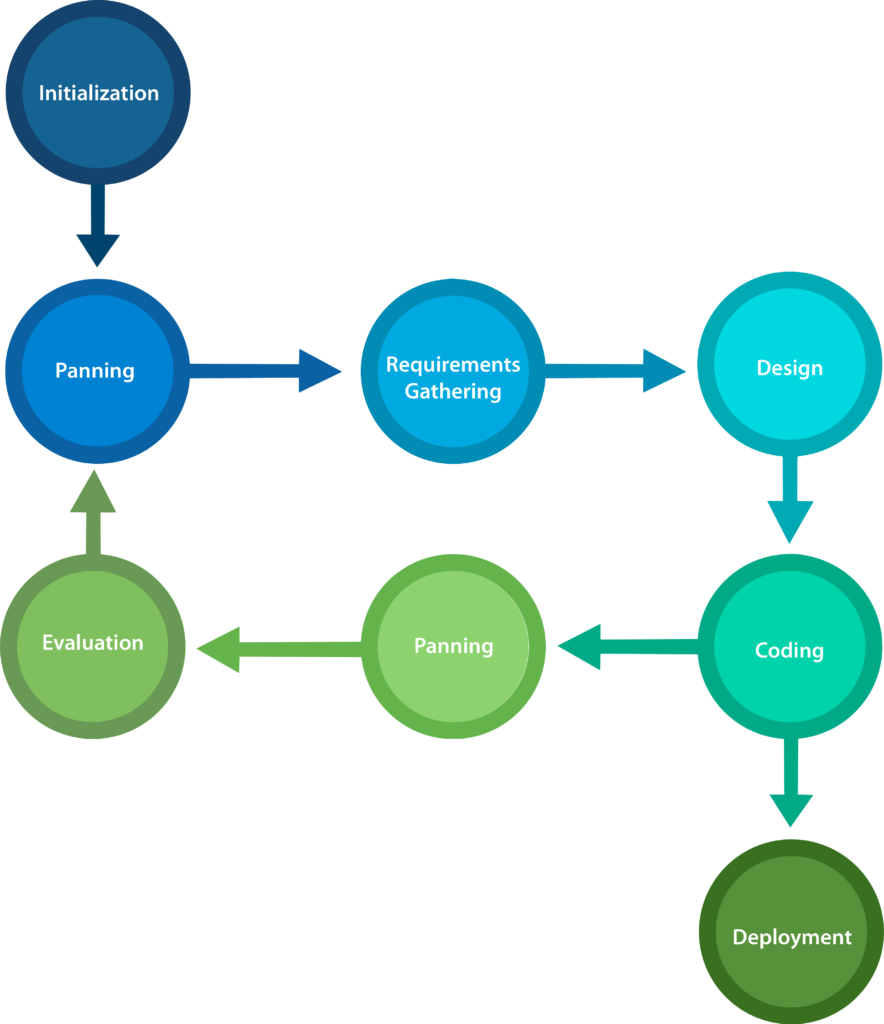
The Iterative Model is a software development strategy that underscores the importance of flexibility and adaptability. It is distinguished by its iterative and incremental methodology, where software development occurs in compact cycles, with each cycle producing a functional segment of the software. This model eases the ongoing testing and feedback, enabling the early detection and resolution of defects during the development phase.
Benefits of the Iterative Model:
- Timely delivery of functional software: Users are provided with functional software components on a regular basis, fostering continuous feedback and realization of value.
- Minimized risk and enhanced quality: The ongoing testing and feedback mechanisms facilitate early identification and rectification of defects, increasing the overall quality of the software.
- Enhanced responsiveness to change: The flexibility inherent in the Iterative Model allows for adjustments to evolving requirements and market dynamics.
- Alignment with user requirements: The emphasis on iterative development and feedback ensures that the software is tailored to meet the needs and expectations of its users.
Drawbacks of the Iterative Model:
- Needs meticulous planning and Balancing. Firstly, the successful implementation of iterative projects demands thorough planning. Coordination is a must to maintain effective iteration sequences and ensure transparent communication among stakeholders.
- A need for cultural transformation: Secondly, transitioning to an iterative approach may need organizational cultural shifts to embrace this methodology effectively.
- Risk of expanding project scope: The inherent flexibility of the Iterative Model can potentially result in scope expansion if not carefully managed.
- Not universally applicable: Finally, the Iterative Model may not be the most suitable choice for projects characterized by strict specifications or those that demand extensive preliminary planning.
Rational Unified Process (RUP):
The Rational Unified Process is structured around multiple iterations within each stage, encompassing four primary stages. A unique feature of this model is that each iteration must satisfactorily meet specific criteria before advancing to the subsequent phase.
Advantages of RUP:
- Emphasis on thorough documentation: This approach prioritizes detailed documentation, indirectly mitigating risks associated with fluctuating consumer requirements.
- Streamlined integration throughout the Software Development Life Cycle (SDLC): Due to its consistent progression, integration is more efficient and consumes less time.
Disadvantages of RUP:
- Requires specialized expertise: The complexity of RUP necessitates team members to possess advanced technical knowledge in their respective domains.
- Potential for confusion in extensive projects: Continuous integration can lead to complexity and confusion, particularly in larger projects.
Rapid Application Development (RAD):
Similar to the Agile model, Rapid Application Development is an incremental approach where component development occurs concurrently. This will be followed by assembly during the developmental phase.
Advantages of RAD:
- Accelerated development through simultaneous component creation. The concurrent development of components reduces the overall development time. It allows for component reusability.
- Efficient resolution of integration issues. As integration is initiated early in the process, any potential issues are promptly identified and addressed.
Disadvantages of RAD:
- Firstly, the requirement for a proficient testing team. The success of RAD hinges on a team with strong testing capabilities and a deep understanding of business needs.
- Secondly, limited applicability to modular systems. RAD’s module-based nature restricts its suitability primarily to systems that can be modularized.
- Finally, potentially high costs. The rapid and parallel development can lead to increased costs, making it less suitable for budget-constrained projects.
Choosing the Right Software Model:
Selecting the appropriate software testing model is not a straightforward decision. Each testing approach has its advantages and disadvantages, tailored to specific project requirements, client expectations, project timelines, and organizational needs.
Advantages of using the Software Testing Models:
1. Early identification of defects:
Detecting and addressing bugs in the early stages of development can lead to significant cost savings. Addressing issues during the development phase is more economical than clearing deeply rooted problems in the code later on.
2. Enhanced software quality:
Implementing software testing models is crucial for increase the quality of software products. These models employ various testing techniques to improve reliability, functionality, and user-friendliness. This will result in a stable and high quality end product that meets user expectations.
3. Minimized risk of system failures:
Software failures can have detrimental effects on businesses and organizations, leading to costly downtime, data breaches, and reputational damage. Testing models help identify and rectify potential issues proactively, reducing the risk of system failures and associated consequences.
4. Increased customer satisfaction:
Delivering top-quality software is essential for maintaining customer satisfaction and loyalty. Effective software testing models ensure that the software performs as expected. This will meet the user needs and enhancing overall user satisfaction.
5. Compliance with industry regulations:
Many industries have specific regulations and standards governing software development and testing. Utilizing appropriate testing models helps organizations ensure compliance with legal and industry-specific requirements, avoiding potential penalties and legal issues.
6. Cost-effectiveness:
Investing in robust software testing models can yield significant cost savings in the long run. Early detection and resolution of issues reduce the need for costly rework, maintenance, and potential liabilities associated with software defects.
7. Boosted productivity:
Software testing models provide a structured framework for testing, streamlining the development process, and accelerating time-to-market for software products.
8. Improved team collaboration:
Effective software testing models foster collaboration between developers and testers. This will ease better communication, shared understanding of requirements, and more cohesive teamwork. This will ultimately lead to a more efficient and effective development process.
[Want to learn more about the various Software Testing Models and why software testing is crucial for your business? Click here to reach us.]
Conclusion
Choosing the right software testing model is crucial for quality assurance and successful software development. Whether it’s Agile, Spiral, or the Rational Unified Process, each model offers unique benefits tailored to specific project needs.
With the support of an outsourced team like Bobcares, organizations can leverage advanced tools. They can bring in expertise to enhance testing efficiency and accuracy. Investing in robust testing models and collaborating effectively between development and testing teams are essential steps. This will help toward delivering high-quality software solutions that meet user expectations and drive business success.
PREVENT YOUR SERVER FROM CRASHING!
Never again lose customers to poor server speed! Let us help you.
Our server experts will monitor & maintain your server 24/7 so that it remains lightning fast and secure.







0 Comments